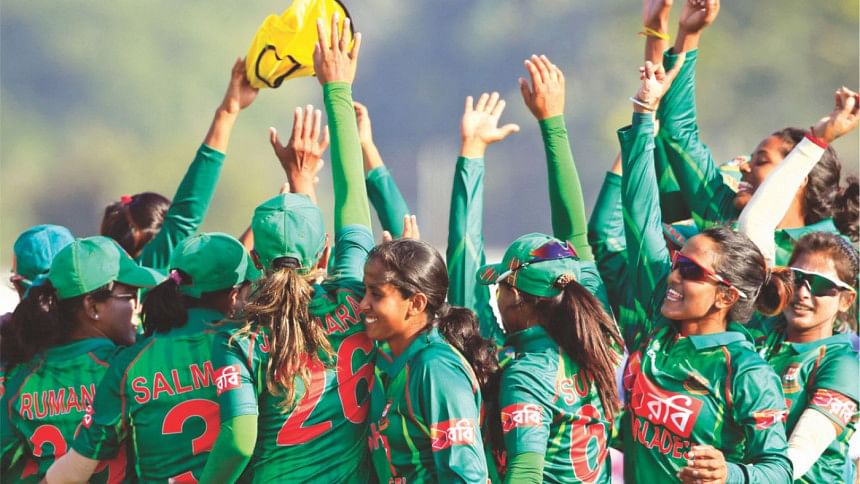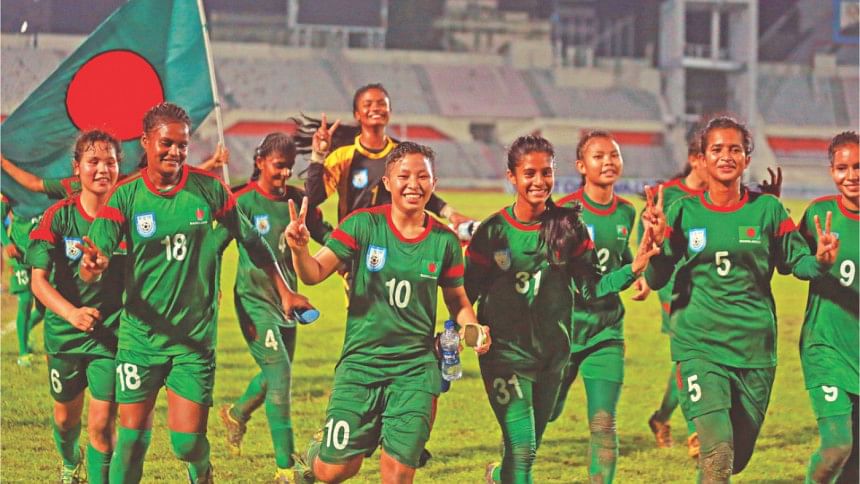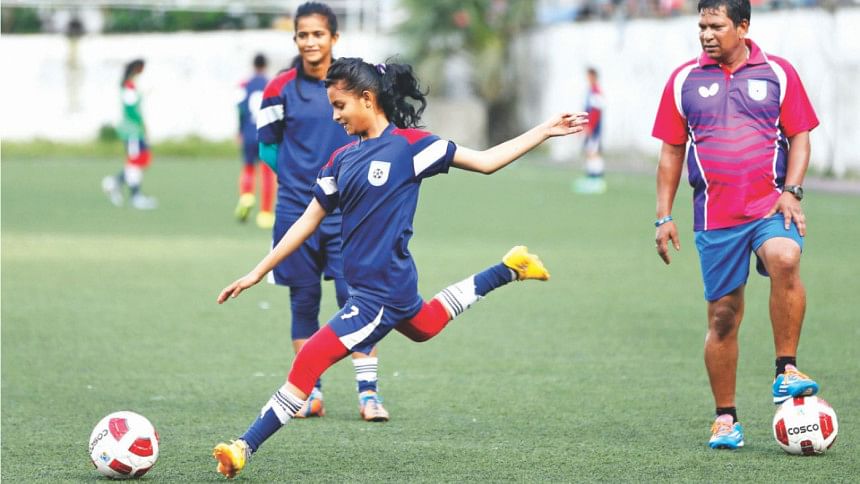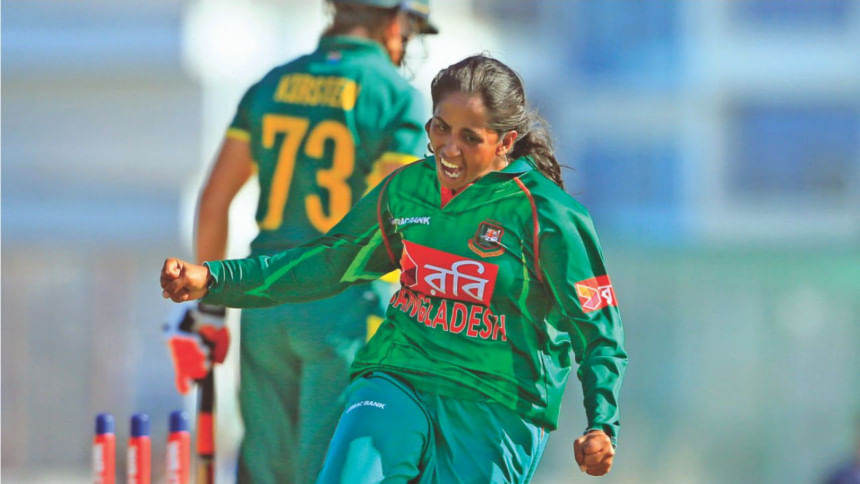Not yet a country for sportswomen

It was the evening of September 2016. A brilliant display of attacking football by Marzia and Co helped Bangladesh's Under-16 women's team come back after conceding an early goal to beat their closest group rivals, Chinese Taipei, in the Asian Football Confederation's Under-16 Women's Championship Qualifiers. The intense finish sealed the girls a spot in the much-coveted final round of the Championships.
It was a fabulous achievement. To land an opportunity to play against the best in Asia is a feat that had only been achieved once before by a Bangladeshi team and that was back in 1980, when the senior Bangladeshi men represented the Men in Green in Kuwait.
The achievement was historic and the hosts had managed to end the tournament on a good note, but the manner in which the girls were supported by the Bangladesh Football Federation over the entire tournament raised plenty of questions.
While the international teams were kept in a luxurious city hotel, the Bangladesh girls were lodged in a dormitory of the Bangladesh Football Federation (BFF) for two and a half months. The move to keep the Bangladeshi girls in a dormitory as opposed to a hotel was apparently taken in order to save some money.
The Asian Football Confederation had given the BFF BDT 1.7 crores to host the six-team Qualifers, but the BFF needed BDT 50 lakh more to complete the tournament and they went on to save around BDT 22 lakhs by keeping the girls in a dormitory. The message that was given to the girls was simple—you may be champions, but you are still not top on the priority list. The above instance is perhaps one of the best examples of the dire situation of Bangladesh's female athletes.
“Honestly speaking, there's no money in football for women. You can say that it's almost never there,” laments Sabina Khatun, Bangladesh women's football captain. Aside from playing for the national team, Sabina also coaches the Bangladesh Under-15 football side and her observations with regards to the younger players paint a rather bleak picture.

“We have a lot of talent. It's not that easy to get into the national team these days. You actually need to be really good and competitive,” she explains. “But the problem is that a majority of the girls who come to play football are from poor families. They all need financial support. Their families send them here because they know that there is a way that they can earn from football. But it's difficult. Money doesn't come by easily.”
While members of the national team are supposed to get money on a monthly basis from the BFF, Sabina and a number of other players claim that the payment does not come on a regular basis and that they are forced to depend on other sources.
“When the girls [Bangladesh Under-16s] won the championship, our prime minister announced that each player would get BDT one lakh. That was a good move no doubt, but it just shows that the players are only benefited when they can show results,” says Sabina.
“If we can't show results, then we have to go back to level zero. So what's the point of all the hard work? These girls work hard throughout the year and they should get paid regularly for that. If they don't get what they deserve, then that will just be sad,” explains Sabina.
BFF General Secretary, Abu Nayeem Shohag admits that the board has not been able to pay the players on time on a regular basis. He however, claims that the board has cleared all its payments till December 2017.
“After the Under 16 girls won the Qualifiers in 2016, an organisation had come forward to fund the girls for the next one year. That funding got over in 2016 September. Ever since then, the board has been finding ways to pay the girls on its own,” explains Shohag.
Payment is just one of the issues that Bangladesh's women footballers are struggling with. A bigger concern is that many of these professional footballers are struggling to get enough game time. 2013, around five years ago, was the last time a women's football league took place in Bangladesh. There is no concrete timetable set for the next league and that is hurting the game.
“In the last few years, Bangladesh's women's football has achieved a lot, even more than men's football. The government and the BFF need to realise that there's a lot of potential here. We need their support and we need to form a proper salary structure with proper grades,” says Sabina.
One may blame the cash-strapped BFF for the troubles faced by the footballers, but the situation is not a far deal better as far as Bangladesh's top sport is concerned.
The Bangladesh women's cricket team has, time and again, broken several barriers in international cricket. They have beaten higher-ranked teams like South Africa, Sri Lanka and Pakistan at an earlier stage than expected. Former captain Salma Khatun was adjudged the world's number one all-rounder right after Bangladesh's first performance at a world event.
However, the fact remains that they still earn a match fee of just BDT 600 per domestic game. The men, on the other hand, earn up to BDT 50,000 per match.
“What can I say about the match fee. It's quite shameful, honestly speaking. It's not a topic that I am comfortable talking about. I mean, how can you even tell someone that you earn BDT 600 per match? It's embarrassing,” says Bangladesh's cricket captain, Rumana Ahmed.
The Bangladesh Cricket Board (BCB) has blamed the dearth of sponsors for the poor payment of the female cricketers. Board officials say that while there's plenty of money coming into the men's team, not much is allocated for the women.
“Sponsors are difficult to come by for the women's team. They look to invest in things that are more or less guaranteed to give them some kind of mileage. And that will only happen once the women's team starts performing well. Why will they come here otherwise?” says Shafiul Alam Chowdhury, chairman of BCB's women's wing.
Despite all the troubles, Rumana still fails to understand why the difference in payment is so huge. “Look, it's very simple. We are professional cricketers. We call ourselves cricketers and not women cricketers. We play on the same pitch and the same ground as the men and we work as hard as them. For the amount of work that we do, we don't earn enough. If the board helps us, it will be really good,” she says.
As per the current contract, the highest salary for the men's side is BDT 400,000 per month, while that of the women's team is BDT 30,000. And this amount, along with that of the match fee, isn't likely to change any time soon.

“It's true that we have all ignored women's cricket to a certain extent, whether or not people admit it is a different issue. But I can't change everything in just one season. We will change things for the better gradually,” says Shafiul.
“I did ask the BCB to increase the salary of the cricketers, but the board, at this point of time, has asked me not to concentrate on so many issues at one go. You see, we are working on building age-level teams for women and organising school tournaments to get more players in the pipeline. Salary increments will take place in the next chapter,” he adds.
The point that Shafiul makes raises another important issue: the absence of a proper pipeline. Despite having made good progress in the last few years, the fact remains that Bangladesh women's cricket does not have any age-level teams. A good age-level system is considered to be a stepping stone towards a successful national team. There was a time in the past when Bangladesh's Under-15 and Under-19 teams shone even as the national team struggled. It is from these age-level teams that the likes of Shakib Al Hasan and Mushfiqur Rahim have emerged.
The fact that the BCB is just about to begin the age-level programme for the women cricketers just goes to show how much the BCB has missed out on. Rumana is someone who has experienced the troubles of a problematic pipeline first-hand.
“Most of the players in women's cricket come either from Khulna, BKSP or Dhaka. And that's because the divisions don't have adequate facilities to support women's cricket. There are many cricketers who are forced to leave everything and come to Dhaka just to pursue their dreams,” explains Rumana.
“It's easier for footballers. But for cricketers, they need grounds and equipment which are expensive. For the men's team there are plenty of facilities, but we don't have that. If we want more youngsters to follow their dreams, we need to support them by giving them the chance.”

A similar problem exists in football as well. Yes, the rise in school football has helped unearth a number of fresh footballers. However, speak to divisional coaches from outside Dhaka and they will tell you that there are a number of young, very talented football players who are going unnoticed because of an improper scouting system.
It's difficult as it is to convince parents from rural areas to allow their children to get into sports. Just ask Mofiz Uddin, the coach of Kalsindur Government Primary School, an institution that won the Bangamata Gold Cup, a girls' football competition, thrice and produced a number of players who play for the national team today. He was called a mad master and a marriage-destroyer just because he initiated a programme to train girls.
And when you combine a lack of importance and the absence of proper structures to these cultural restrictions, the problem only worsens. The fact that women continue to struggle in two of Bangladesh's most successful sports shines an even brighter spotlight on how difficult the situation is.
Bangladesh cricket captain Rumana is content with how far her career has come. She bowls leg-spin, a rarity in Bangladesh, and is the only Bangladesh female cricketer to take a hattrick. However, she remains concerned about the future of the sport.
When asked if she has a message for young girls who aspire to be cricketers, she says: “Before telling the youngsters anything, I would like to request the media to come forward and give the amount of coverage to the women that they deserve. Today, there are still places in Bangladesh where they don't even know that women can actually play cricket. We need to have a special focus on women athletes. We need to change this.”





Comments